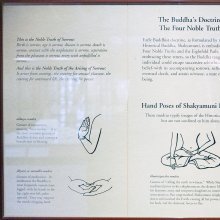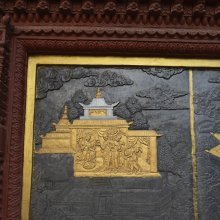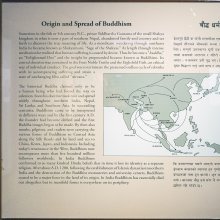Four Noble Truths: 8 definitions
Introduction:
Four Noble Truths means something in Buddhism, Pali. If you want to know the exact meaning, history, etymology or English translation of this term then check out the descriptions on this page. Add your comment or reference to a book if you want to contribute to this summary article.
Images (photo gallery)
In Buddhism
Theravada (major branch of Buddhism)
Source: Dhamma Study: Introduction to the DhammaThe root of Dependent Origination is ingnorance. That is defined as ignorance of the Four Noble Truths.
The Four Noble Truths state that:
- Life is unsatisfactory or suffering (dukkha).
- Suffering arises because of desire.
- There is a path leading to the cessation of suffering.
- The path leading to the end of suffering is the Eightfold Path.
When one does not understand these truths directly one is subject to continual rebirth in the wheel of existence.
Source: Pali Kanon: Manual of Buddhist Terms and Doctrinesthe 4: ariya-sacca; s. sacca. - The 2-fold knowledge of the n.t.; s. sacca-ñāna.
Source: Pali Kanon: Manual of Buddhist Terms and Doctrinesthe 4 Noble: sacca. - 2-fold knowledge of the t.; s. saccañāna.
Theravāda is a major branch of Buddhism having the the Pali canon (tipitaka) as their canonical literature, which includes the vinaya-pitaka (monastic rules), the sutta-pitaka (Buddhist sermons) and the abhidhamma-pitaka (philosophy and psychology).
General definition (in Buddhism)
Source: Wisdom Library: Dharma-samgrahaFour Noble Truths:—A technical term in Buddhism corresponding to the Sanskrit caturāryasatya defined in the Dharma-saṃgraha (section 21):
- Suffering (duḥkha),
- Arising (samudaya),
- Cessation (nirodha),
- Path (mārga).
The Dharma-samgraha (Dharmasangraha) is an extensive glossary of Buddhist technical terms in Sanskrit (e.g., catur-āryasatya, ‘four noble truths’). The work is attributed to Nagarguna who lived around the 2nd century A.D.
Source: Wisdom Library: BuddhismFour noble truths:—The first teachings from the Agama Sutras. They are explained in chapter one under the heading “monastic teachings.”
Source: Buddhist Door: GlossaryIt is the primary and fundamental doctrines of Shakyamuni
- Doctrine of Suffering - suffering is a necessary attribute of sentient existence (Effect of Suffering)
- Doctrine of Accumulation - accumulation of suffering is caused by passions (Cause of Suffering)
- Doctrine of Extinction - extinction of passion (Effect of Happiness)
- Doctrine of Path - Path leading to the extinction of passion (Cause of Happiness); i.e. Eightfold Path.
The first two are considered to be related to this life, and the last two to the life outside and beyond this world. The Four Noble Truths were first preached to Shakyamunis five former ascetic companions.
Source: WikiPedia: BuddhismThe Four Noble Truths are one of the most fundamental Buddhist teachings. In broad terms, these truths relate to suffering (or dukkha), its nature, its origin, its cessation and the path leading to its cessation. They are among the truths Gautama Buddha is said to have realized during his experience of enlightenment.
- The Nature of Suffering (Dukkha):
"This is the noble truth of suffering: birth is suffering, aging is suffering, illness is suffering, death is suffering; sorrow, lamentation, pain, grief and despair are suffering; union with what is displeasing is suffering; separation from what is pleasing is suffering; not to get what one wants is suffering; in brief, the five aggregates subject to clinging are suffering." - Sufferings Origin (Samudaya):
"This is the noble truth of the origin of suffering: it is this craving which leads to renewed existence, accompanied by delight and lust, seeking delight here and there, that is, craving for sensual pleasures, craving for existence, craving for extermination." - Sufferings Cessation (Nirodha):
"This is the noble truth of the cessation of suffering: it is the remainderless fading away and cessation of that same craving, the giving up and relinquishing of it, freedom from it, nonreliance on it." - The Way (Marga) Leading to the Cessation of Suffering:
"This is the noble truth of the way leading to the cessation of suffering: it is the Noble Eightfold Path; that is, right view, right intention, right speech, right action, right livelihood, right effort, right mindfulness, right concentration."
Certain major Mahayana sutras, including the Mahaparinirvana Sutra and the Angulimaliya Sutra, present variant versions of the Four Noble Truths.
Source: Amaravati: Glossary- The Noble Truth of Suffering.
- The Noble Truth of the Origin of Suffering.
- The Noble Truth of the Cessation of Suffering.
- The Noble Truth of The Way Leading to Cessation of Sufferring.
Four noble truths (Skt., ārya-satya; Pali, ariya-satta); these are the basis of the Buddhist teaching. The four noble truths are
- the truth of suffering (duhkha);
- the truth of the origin (samudāya) of suffering;
- the truth of the cessation (nirodha) of suffering;
- the truth of the path that leads to the cessation of suffering.
1) The first truth says that all existence is characterized by suffering and does not bring satisfaction. Everything is suffering: birth, sickness, death; coming together with what one does not like; separating from what one does like; not obtaining what one desires; and the five aggregates (skandha) of attachment that constitute the personality.
1) The second truth gives as the cause of suffering craving or desire, the thirst (trishnā) for sensual pleasure, for becoming and passing away. This craving binds beings to the cycle of existence (samsāra).
3) The third truth says that through remainderless elimination of craving, suffering can be brought to an end.
4) The fourth truth gives the eightfold path as the means for the ending of suffering.
Nonrecognition of the four noble truths is ignorance (avidyā).
The discovery of the four noble truths by the Buddha constituted, according to the various traditions, his actual enlightenment (bodhi). Buddha expounded these truths in the Benares discourse as his first teaching immediately after his enlightenment.
See also (Relevant definitions)
Full-text (+54): Samudaya, Caturaryasatya, Marga, Nirodha, Duhkha, Buddha, Ariya Sacca, Anupubbikatha, Samma Ditthi, Noble Truth, Voice Hearer, Arya Satyas, Agama Sutra, Vadha Alopa Sahasakara Sutta, Abhisamaya, Kulaputta Sutta, Vijja, Tatha Sutta, Dandaka Sutta, Cela Sutta.
Relevant text
Search found 130 books and stories containing Four Noble Truths; (plurals include: Four Noble Truthses). You can also click to the full overview containing English textual excerpts. Below are direct links for the most relevant articles:
The Buddha (by Piyadassi Thera)
A Discourse on Paticcasamuppada (by Venerable Mahasi Sayadaw)
Chapter 14 - The Four Noble Truths In Brief < [Part 10]
Chapter 12 - Sammasambuddha < [Part 10]
Chapter 15 - Sammasambuddha And Buddhahood < [Part 10]
The Buddhist Path to Enlightenment (study) (by Dr Kala Acharya)
2(a). The Four Noble Truths < [Chapter 3 - Seven Factors of Enlightenment and Noble Eightfold Path]
1.3.4. Dhammānupassanā–Contemplation Of The Dhamma < [Chapter 2 - Five Groups of Factor]
2.1. Right Understanding (Sammā-diṭṭhi or Samyag-dṛṣṭi) < [Chapter 3 - Seven Factors of Enlightenment and Noble Eightfold Path]
The Four Noble Truths (by Ajahn Sumedho)
Introduction < [Chapter 3 - The Third Noble Truth]
The View From the Center (by Ajahn Amaro)
Philosophy of language in the Five Nikayas (by K.T.S. Sarao)
6.3. The Four Noble Truths < [Chapter 3 - Language and Meaning as Reflected in the Five Nikāyas]
1. General View < [Chapter 6 - Summary and Conclusions]
2.5(a). The Sutta Piṭaka (Introduction) < [Chapter 1 - Introduction]


